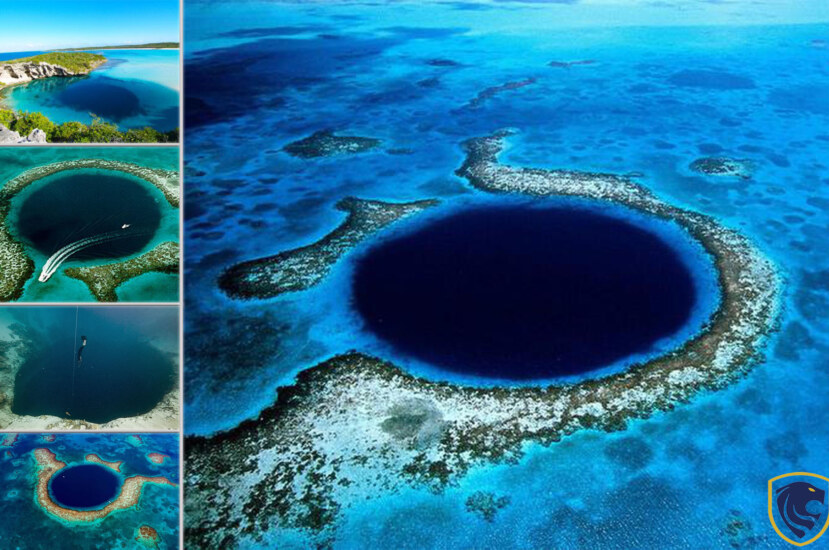The blue hole is located in the Bahamas. About 30 – 35 miles northwest of Acklins Island and about 35 – 40 miles southeast of Long Island Sound. The limestone is porous and contains a number of natural sinkholes or caves, along with a small spring-fed pool surrounded by tropical foliage and sand. The pool is much deeper than the surrounding waters, so it is considered a blue hole.
The color of the water around the hole comes from the nutrient-rich algae that grow there. The blue color is not from pigment but from the light-scattering properties of water particles in the algae’s photosynthetic cells. The depths of Dean’s Blue Hole vary because the area has been eroded over time by tides. This erosion allowed for a cave to form, or sinkhole, which offered a place for fresh water and saltwater fish such as grouper and conch to coexist.
Why is it called Dean’s Blue Hole?
The name comes from Professor William “Bill” Dean. He is an American geochemist who was on a quest to identify the chemicals that made up seawater. William took a sample from the blue hole in 1932 (the same year he discovered it!). And found that the water was fresh, not salt, as many people thought. He also found out it had very low levels of salinity, much lower than in any other tropical sea.
It is situated in the Bahamas and is Earth’s deepest known blue hole. Its maximum depth reaching 518 m (1,750 ft). The water at the bottom of the blue hole has a constant temperature of 3.2 °C (38 °F), which means it would take an hour to reach this temperature if you were to dive from the surface. This fact makes it one of the best diving locations on Earth.
In order to visit this awesome location off, there’s only one way: by boat. Luckily, this is a very popular destination among tourists, backpackers, and divers.
The blue hole got its name because of its characteristic color: a deep dark blue with shades of green contrasting against the sky above it. When driving around the area, it’s hard not to be impressed by the enormity of this hole. It’s a very deep hole with a semi-circular perimeter and a maximum depth of 518 m (1,750 ft).

Dean’s blue hole; The world’s largest sinkhole, Bahamas
How deep is it?
There are many different levels that make up the blue hole. From a 300 m (1,000 ft) depth to 518 m (1,750 ft), that’s over 700 meters (2,300 ft) below the surface! The bottom of the blue is covered in fuzz balls formed from algae and bacteria living in open water – allowing for even more amazing visibility at depths of 300-500m.
The depth of the water in the blue hole is not always constant, as if it was a massive container. The deep water comes from an underwater spring, which brings water to the surface from underground. On top of that, a current constantly changes the water levels in the blue hole. This means that once you reach a certain depth, you will not be able to see the surface and will have to rely on your dive guide in order to find your way back above ground.
The Dean’s Blue Hole is located within the Long Bay Marine Park. It is strictly prohibited to enter the hole without a guide. A dive at Dean’s Blue Hole will take approximately 60-90 minutes, and it is possible to go as deep as 300 m (1,000ft).
This blue hole opens up into the ocean, and it’s possible to see barracuda, stingrays, and even sharks swimming in the water. The visibility at Dean’s Blue Hole ranges from 20 m – 200 m (65 ft – 650 ft). Depending on how deep you go, you will encounter different types of fish like trumpetfish, southern stingray, and golden snapper. There are also a number of tiny species of fish called fusiliers that are native to this location.

diving in Dean’s Blue Hole, Bahamas
sharks are common
The one person known to have died in Dean’s Blue Hole was a man named Michael Walker. He was killed there on June 24, 2009, by a shark. Although sharks are common in the hole, they rarely attack humans. There was an attack in 2006, and two sharks were seen attacking a dolphin floating in the hole on March 6, 2011. It is believed that the dolphin died before being eaten. While some of these attacks happened at the same time of year, it is not believed that they were related to one another.
It is currently a protected marine environment and the only known sinkhole in the Bahamas. It is open to the public and has been described as a “natural wonder” by locals. Because of its sheer size, depth, and unique colors. The blue hole is located within a protected marine environment that surrounds both the limestone bedrock and the pool of fresh water at its bottom. The Marine Conservation Area (MCA) surrounding Dean’s Blue Hole encompasses.
If visitors would like to view Dean’s Blue Hole, they are asked to stay within the MCA boundary for their safety. By staying in this area, visitors will be able to see Dean’s Blue Hole at all times of day. But night viewing is not advised for safety reasons. This marine conservation area is a protected area that helps preserve the blue hole from pollution and the marine life near it. Even though this is a marine conservation area, there are many tours that help people see Dean’s Blue Hole.

sharks in Dean’s Blue Hole, Bahamas
Activities in the area
Tourist operators in tours to Dean’s Blue Hole will use a boater, who will take you by boat to the blue hole. They will help take your camera out of the water and show you the blue hole. Before you jump into the sinkhole, they’ll teach you how to do a nerve-wracking dive.
After several dives in a row, they’ll bring you back to land safely. The second-hand price of this activity lies between $125 and $200 USD. It is advisable that visitors wear proper clothing when diving into Dean’s Blue Hole, as it is known for attracting sharks. The blue hole is home to these sharks, and the blood from one’s ears attracts them.
The main reason why so many people visit Dean’s Blue Hole, Bahamas is because of its amazing visibility. Many people have visited this famous hole. But only a few have been able to withstand the pressure needed to enter. Several divers have lost their lives due to this pressure and wonder about the water pressure at Dean’s Blue Hole.
The truth is that being inside the blue hole will be one of the scariest things you will ever go through, but it’s also one of the most amazing things you’ll do in your life. It will truly be worth it! A visit to Dean’s Blue Hole will be one of the most amazing experiences you’ll ever have in your life. If you’re a strong swimmer, go for it.




